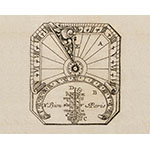The day is the time interval in which the Earth completes a full revolution around its axis and returns to a point in the sky under the same meridian. The day is called "sidereal," if defined by two successive passages of a star on the meridian of a given locality; "true solar," if defined by two successive culminations of the Sun; "mean solar," if defined by the annual mean of the true day; and "lunar," if defined by two culminations of the Moon at the same point above the horizon.
The day is divided into 24 hours of 60 minutes referred to as "true," "mean" or "local," depending on whether they are defined by the true day (which varies continuously), the mean day (of constant duration throughout the year), or the interval between mean local midnight and the Sun's culmination on the local meridian. Local hours are shown by sundials and nocturnal clocks, which depend on the timing of astral phenomena; by contrast, on mechanical clocks, the hours denote a conventional division of time.








